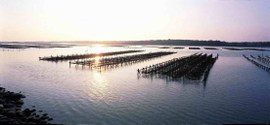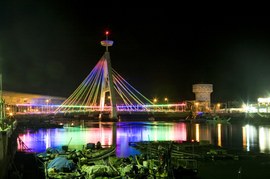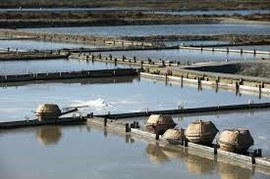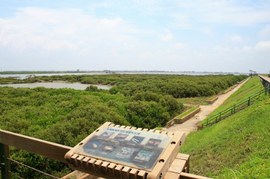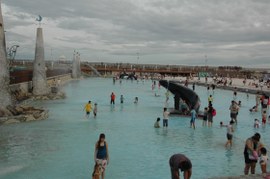A Tour of Salt fields and Wetland Ecology
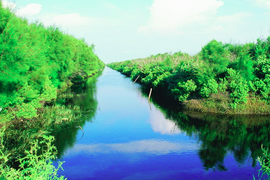
Aogu Wetland Forest Park
Bengangkou Gangkou Temple
When the mainland Chinese immigrated to Taiwan in 1684, in the 23rd year of Emperor Kangxi's reign in the Qing Dynasty, they brought with them for protection a golden Mazu statue from Meizhou's Chaotian Pavilion. After arriving on Taiwan Island, they enshrined the statue in Hanziliao following a divine oracle. A large collection of rare antiques that include plaques and stone tablets, in addition to the rooftop details remain intact at this quaint temple.
Aogu Wetland Forest Park
The wetland in Aogu Village, Dongshi Township, was formed by sediment carried by the Beigang River and Liujiao Drainage Channel, both situated to it's west. In the Qing dynasty, lagoons and sandbars began to develop in Aogu's once navigable waters, where flood-proof embankments were built starting from the Japanese colonial period. When subsidence-triggered wetlands emerged and aquaculture thrived along Taiwan's southwest coast in the 1970s and 1980s, Augo surprisingly attracted migratory birds and became a crucial midpoint of the Asia-Pacific bird migration route. Statistics show that 43% of Taiwan's bird species have been spotted in the park; such a considerable variety reflects the fact that 52 families and 243 species of resident or migratory birds, including rare raptors, have appeared in the park. Inautumn and winter each year, the migratory birds never fail to attract crowds of photographers to Augo.
Dongshi Fisherman's Wharf
An iconic tourist attraction on Chiayi County's coastal line, the Dongshi Fisherman's Wharf has a multi-faceted appeal that consists of such elements as sea breeze, sunshine, fishing, boats, ocean and lighthouse. The revamped image of Fisherman's Wharf and Dutch-style entrance evoke a distinctively coastal ambiance. While the sand beach, ocean-viewing pavilions and seaside boardwalk are perfect for fun in the daytime and sunset-viewing or star-gazing in the evening, the wharf integrates diversified services typical of a seaside resort with fishing port facilities. Visitors will definitely be captivated by how the sky and ocean merge into one while kite-flying on the sprawling law, cycling, running, or strolling on the breeze-swept viewing platform. In recent years, people from all over Taiwan have been lured to the large-scale summer festivals on Dongshi's beach, as well as the restaurants near Dongshi Fishing Port that prepare mouth-watering seafood from live marine catches.
Puzi River ecology
The Puzi River originates in Yucaikeng, a village in Mt. Tianwang of the Alishan mountain range. This 76-kilometer river winds through the Jianan Plain before reaching Dongshi Township near Chuanzitou, which is an estuary zone strewn with sand bars and wetlands. The section of Puzi River between Dongshi Bridge and Dongshi South Bridge is teeming with fiddler crabs and Mudskippers, in the midst of a mangrove that is considered a national treasure. It demonstrates an impressively diversified ecosystem where thousands of egrets gather together.
Zhounan Salt Field
Fishery and salt production thrived in Budai since the Qing dynasty, and sacks loaded with fish and salt constituted a common sight in the glorious past. In 1824, the Zhounan Salt Field was built in the heyday of Taiwanese salt fields. However, the practice of sun-drying salt was abandoned in 2002 as Taiwan replaced domestically produced salt with imports. In an effort to reintroduce Budai's cultural heritage based on salt fields, the Budaizui Cultural Association breathed life into the Zhounan Salt Field according to a vision of "happiness-infused salt fields in a heart-warming salt village," and a sustainability strategy centered on "environmental education and event industry." Having lain idle for 6 years, the Zhounan Salt Field is now a combination of salt production, salt field-oriented lifestyle and an ecological system. Visitors to this cultural, tourist and educational spot can experience, with their own hands and feet, both the salt field's former essence and it's new charm.
Budai Fishing Port
heport was formerly named "Budaizui" (mouth of the sack) for it's sack-shaped area, and development started since the reign of Koxinga in the Ming Dynasty. Reputed as "home to the spear shrimp," it is rich in fishery resources and tours oysters and hard clans as it's two most famous products. The adjacent tourist fish market has a raw seafood section, a seafood-processing area and food court, and offers freshly caught seafood, besides such must-try classics as oyster-stuffed buns and oyster omelets.
Haomeiliao Nature Preserve
Located where the Bazhang and Longgong River meet the sea, the Haomeiliao Nature Preserve combines a peculiarly scenic sandbar-lagoon land form with various ecological resources, including a mixed-species mangrove where Avicennia marina (gray mangrove), Kandelia candel, Lumnitzera racemosa and Rhizophora stylosa (red mangrove) thrive, river-moth lagoons, sand dunes, fish farms, salt fields and a migratory-bird ecosystem. It offers opportunities to observe birds, intertidal fauna/flora, and coastal sand dunes covered with cacti, Spinifex littoreus, Seashore Vine Morning Glory (Ipomoea pes-caprae) and sea purslane (Sesuvium portulacastrum). In addition to the graceful windbreaks inhabited by an array of birds, the mudflat in Haomeiliao Nature Preserve is windbreaks inhabited by an array of birds, the mudflat in Haomeiliao Nature Preserve is a top choice for ecological observations or education as it stays dry for 3 hours a day.
Source of Article: Culture and Tourism Bureau of Chiayi County
| City | Chiayi County |
| Contact Information | Bengangkou Gangkpu Temple:05-3601002 Aogu Wetland Forest Park:05-2787006#219 Dongshi Fisherman's Wharf:05-3620123#332 Puzi River ecology:05-3620123#332 Zhounan Salt Field:05-3478817 Budai Fishing Port:05-3620123 #332 Haomeiliao Nature Preserve:05-3475979 |
| Location | Chiayi County |
| Transportation | Exit National Freeway 3 at Shuishang System Interchange (300km), or Exit National Freeway 1at Chiayi System Interchange (279.9 km); take Provincial Highway 61 (aka. West Coast Expressway) southbound to downtown Budai or northbound to downtown Dongshi; and you will arrive at the destination (s) from there. Bengangkou Gangkou Temple→5min→Aogu Wetland Forest Park→10min→Dongshi Fisherman's Wharf→10min→Puzi River ecology→10min→Zhounan Salt Field→3min→Budai Fishing Port→10min→Haomeiliao Nature Preserve
|
comments powered by Disqus

